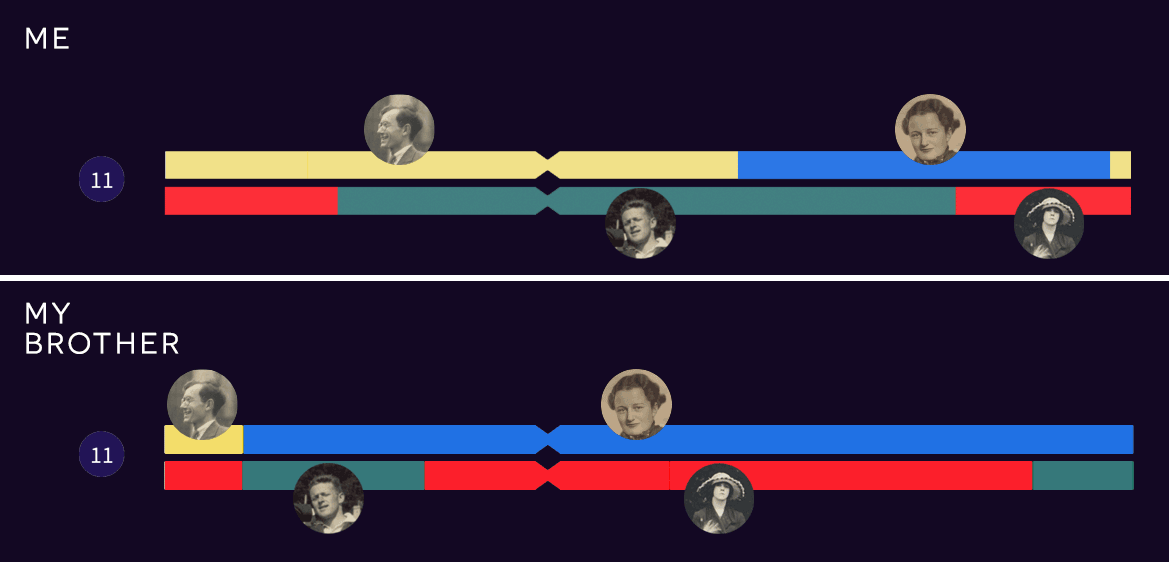In the early days of DNA Painter I wrote an article about how you can use the matches of a parent or sibling to make deductions about your own DNA. Recently, Blaine Bettinger gave a webinar on this topic that has sparked a lot of interest. In this article, I’ll go into more detail about what you can infer with different relatives. I’ll also introduce a new tool I’ve created to make the process of inferred chromosome mapping easier.
Inferred chromosome mapping
If you’re already mapping your chromosomes, you may already be doing inferred mapping without realizing it. For example, if you have a close maternal relative tested and they share a segment that overlaps with a mystery match, you can compare the two kits. You will then discover whether or not they match each other as well as matching you; that is: whether or not the mystery segment triangulates:
- If it does, the segment is on your maternal copy of the chromosome
- If not, you can infer that this segment is paternal
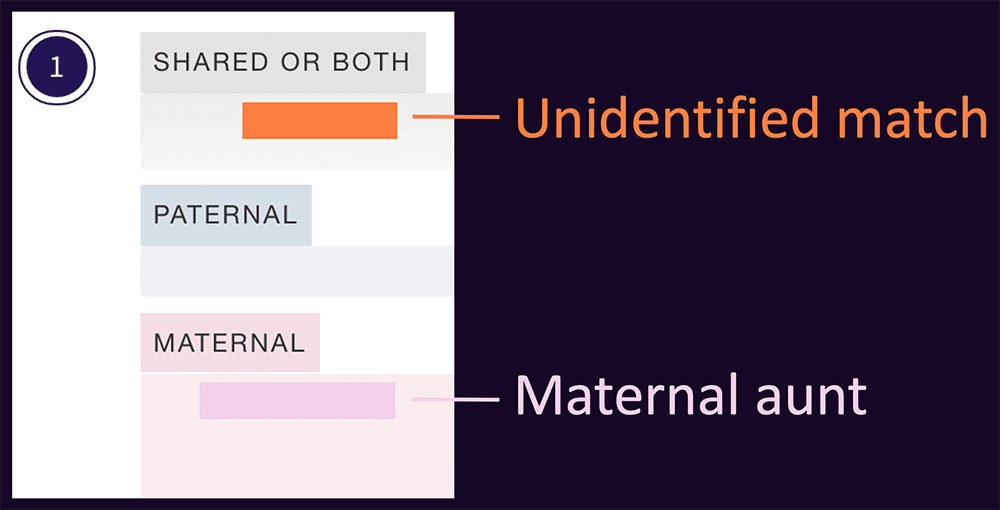
However, if you’re new to the topic, this post will probably make more sense if you read the previous article first. Please bear in mind that a definitive name for this process does not yet exist and you may also come across ‘deductive chromosome mapping,’ which refers to the same thing.
Before you start
In order to undertake inferred chromosome mapping, you will need
- An understanding of the process of mapping and assigning DNA to ancestors (DNA Painter’s help page is probably a good place to start)
- A close relative who has tested:
- Ideally a parent, sibling, or other descendant of one or both parents
- As I’ll explain below, some limited inferring is also possible using another close relative such as a first cousin or grandparent
- Some additional known matches with segment data
- Grandparents who are not related to each other
Inferred chromosome mapping is when you take segments that this close relative shares with another match, but which you do not share with them. You can use this information to infer information about which ancestral branch you inherited DNA from at the position of this segment on this specific chromosome.
To be clear, in order to do this, you and your close relative both need to have your DNA on at least one site that provides segment data for matches. At the time of writing this means 23andme, FamilyTreeDNA, Gedmatch and MyHeritage. This page has links on downloading and transferring your DNA.
What can be inferred using different close relatives?
1: A parent, sibling, half-sibling or any of their descendants who are not your own descendants
If you have the match list of a close relative who is either your parent or a descendant of one or both of your parents, then you can use their DNA to infer which grandparent you inherited a segment from.
Why? Because in these cases the common ancestors are your parents. The DNA you share with them was therefore inherited from the same set of ‘reference chromosomes’ (my term), consisting of the specific blend of DNA that each of your parents inherited from *their* parents:
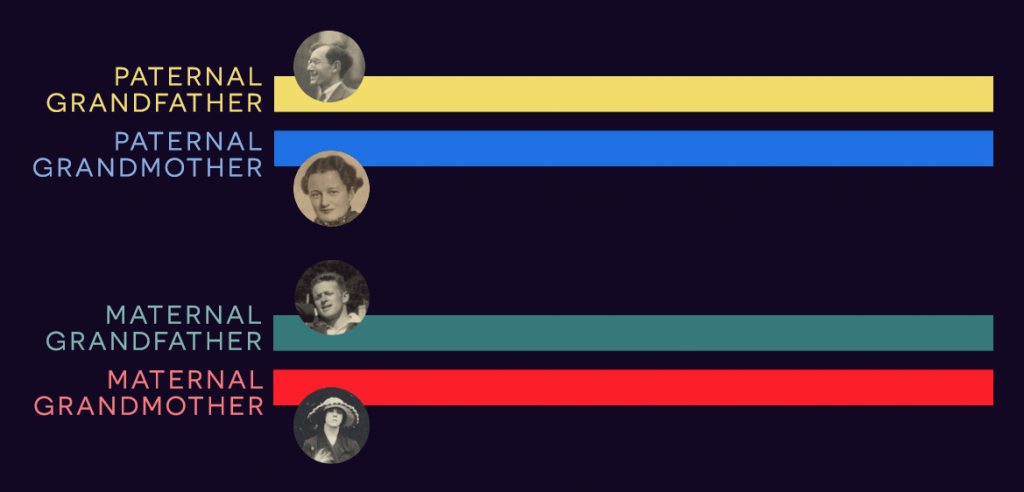
Inferred matching is based on the fact that we all inherit our own personal blend of DNA from our grandparents. For example, my brother and I will have inherited different segments on each of our copies of chromosome 11:
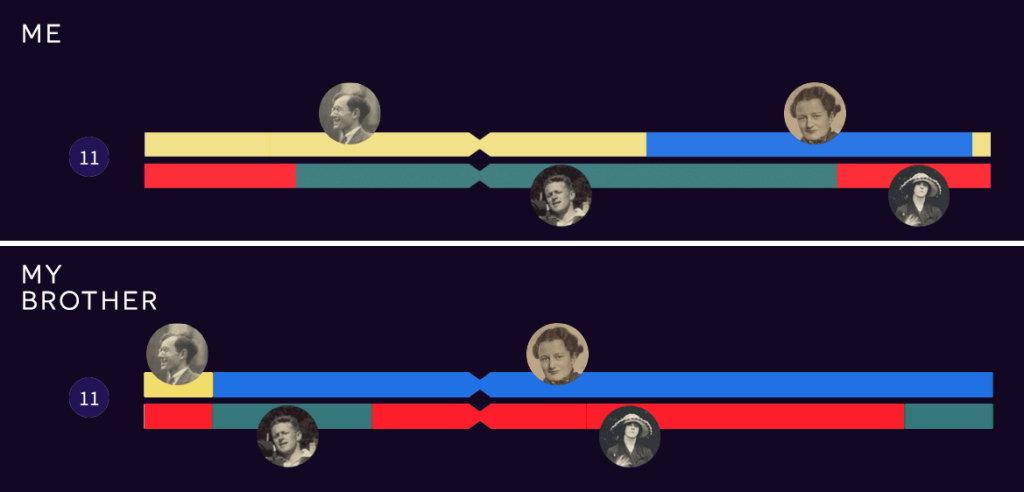
As full siblings, we know we both have the same possibilities for the DNA we inherited in any given position:
- Either yellow or blue on the paternal chromosomes
- Or either green or red on the maternal chromosomes
This means that if I know I didn’t inherit DNA from my paternal grandmother (blue) for the length of a specific segment, then it follows that in this position I instead inherited DNA from my paternal grandfather (yellow) on my paternal copy of this chromosome.
I’m using the paternal side here as an example but the same applies to the maternal copies of your chromosomes.
To reiterate: you can infer the same information (that a segment was inherited from one grandparent rather than another) when you have the DNA segments that any of the following share with a known match:
- A parent
- A sibling or half-sibling
- Any descendants of the above who are not your own descendants
These people all inherited DNA from the same set or subset of ‘reference chromosomes’, but the segments they share with other matches may differ based on them having DNA that you did not inherit from your parents.
2. A first cousin, half-first cousin, or anyone who is not a descendant of your parents
If you have the match list of a grandparent or any descendant of your grandparents who isn’t a descendant of one of your parents, such as a first cousin, aunt or uncle, then the information you can infer is slightly different.
First of all, the ‘reference chromosomes’ — representing the DNA of the closest common ancestors you share with one of these people — are one generation further back. Instead of being your grandparents, it’s your parent’s grandparents.
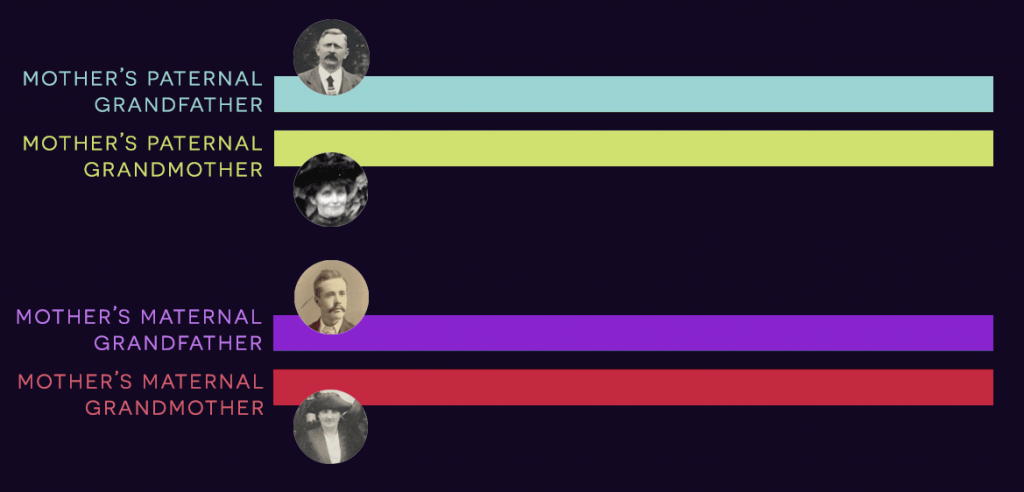
This means that rather than being able to infer a grandparent, you can instead only rule out one of your 4 great-grandparents as being the source of that segment.
For example, let’s take this scenario:
- My maternal first cousin Steve shares 69cM of DNA with Annabel
- Annabel is a known third cousin via a sibling of my mother’s grandfather Sam Hill
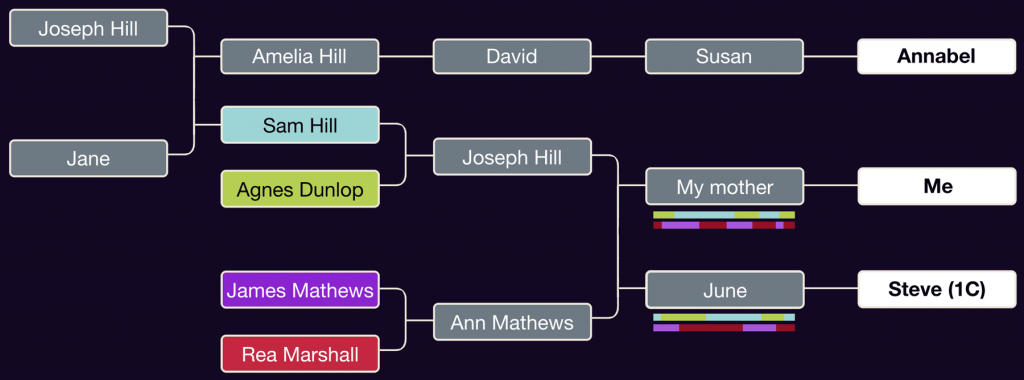
- I share 95cM with Annabel
- However, Steve and Annabel’s match includes a 24cM segment that I do not share
- At this stage, all I know is that I didn’t inherit the DNA on the chromosome where 24cM segment is from Sam Hill (pale blue).
- I might have inherited it from my other maternal grandparent
- But I might also have inherited some or all of it from Agnes Dunlop, Sam Hill’s wife, my other great-grandparent on my paternal grandfather’s side.
- This is because my mother might have inherited DNA at this location from Agnes, while her sister, Steve’s mother, inherited DNA from Sam.
So, what the inferred match tells me in this case is that I didn’t inherit the DNA from Sam Hill. I could therefore have inherited it from any of my other three great-grandparents on my maternal side, or a combination of one or more of them.
As an aside, it’s possible that I do match Steve on a small subset of this segment that is beneath the matching threshold. If an anomaly emerges when comparing this segment to other mapped matches, I can investigate this further.
3. The full aunt / uncle exception
Aunts and uncles
While each segment that I share with my first cousin Steve will almost always have been inherited from just one of the four great-grandparents who are our common ancestors, the same does not apply to DNA shared with a full aunt or uncle.
This is because your parent’s full sibling will share multiple fully identical areas (FIRs) with them. This refers to sections on a chromosome pair where the siblings have identical DNA across both the maternal and paternal copy of the chromosome.
This means that a segment you share with a full aunt or uncle may actually include a mix of DNA from both grandparents on that side. The reason for this is that for your aunt or uncle, the matching segment may in fact be across both copies of their chromosome.
For instance, a segment I share with my niece (my brother’s daughter), may span one of the areas on chromosome 11 where my brother and I inherited identical DNA on both of our chromosomes. Such a segment will be on my niece’s paternal chromosome, but may actually match me first of all on my maternal chromosome and then immediately on my paternal chromosome. It will therefore appear as one segment, but may actually include a crossover from one of my niece’s grandparents to another.
4. The grandparent exception
Similarly, if your grandparent has tested, any segment you share with them may actually span both their maternal and paternal chromosomes and therefore include a mix of DNA from each of their parents.
For more on crossovers and recombination, I recommend this ISOGG wiki page.
Getting started
As a reminder: once you’ve figured out which close relative you can use for inferred matching (e.g. a parent or sibling or other relative as described above), your next steps would be:
- Look up the largest match you and your close relative have in common, and get the segment data for:
- a one-to-one comparison between you and this largest match
- a one-to-one comparison between your close relative and this match
- You are then ready to identify which segments can be inferred, which leads me nicely to my new tool.
The inferred segment generator tool
In my presentation on inferred matching at Rootstech London in 2019, I included a screenshot of an as-yet-unbuilt tool. I’m pleased to announce that the inferred segments generator is now available at https://dnapainter.com/tools/isg
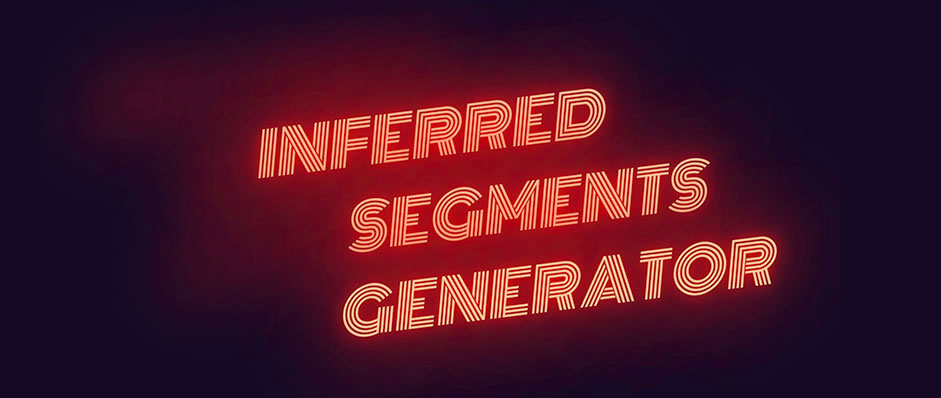
To use it, you need two things:
- The segments you share with a known match where you’re related via just one grandparent (for example anyone more distant than a first cousin)
- The segments that another close relative shares with the match
Once you’ve pasted the segments into the relevant fields (just as you might paste segment data into the ‘Paint a new match’ box at DNA Painter), you can click ‘GENERATE INFERRED SEGMENTS’
The tool will then:
- Find the start and end points for the segments that your close relative shares with the match, but which you do not
- Calculate the cMs for these segments
- Present the inferred segments in tab-delimited format ready for you to use in a spreadsheet, or paint into a DNA Painter chromosome map
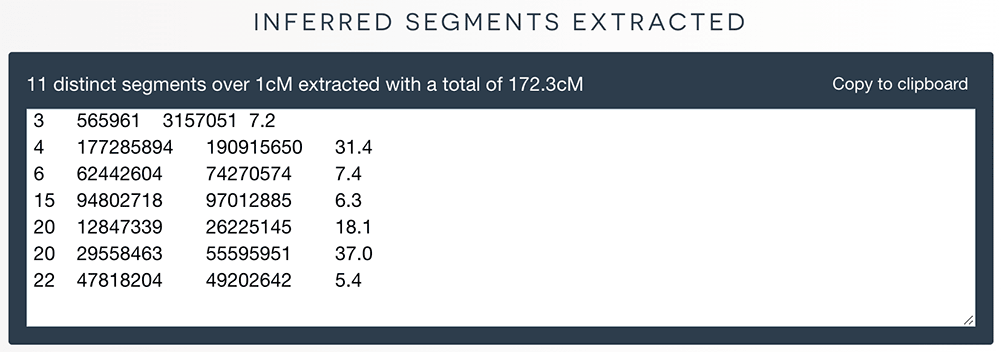
I hope this is useful. In future I’d like to take things further by creating an ‘Inverse segments’ tool, which could for example be used to infer segments inherited from a paternal grandmother using segments shared with a paternal grandmother.
Using inferred segments in your chromosome map
Now that you have the segments, you can map them. Within DNA Painter, I normally do this as follows:
- I copy the segments into the ‘Paint a new match’ form as usual
- I enter the match name as “[match name] Inferred”
- I enter the ancestor as either the individual grandparent name, or the great-grandparent couple who are the parents of the grandparent (in practice the DNA could be from one or both great-grandparents)
- It’s a personal choice whether or not to have a separate ‘inferred’ group, or to assign inferred segments directly to the ancestor or ancestral couple
- If I’m using a first cousin, and am therefore able to infer only that a segment didn’t come from a specific great grandparent, I normally add a specific note at a segment level, and wait until I have more information before assigning the segment more specifically.
Thanks for your feedback!
I’m aware that this topic can be confusing, and am particularly keen for feedback on how clear or not this article is. Please don’t hesitate to contact me with comments or corrections. I’ve already made a couple of updates based on suggestions. Many thanks!
Contact info: @dnapainter.bsky.social / jonny@dnapainter.com
